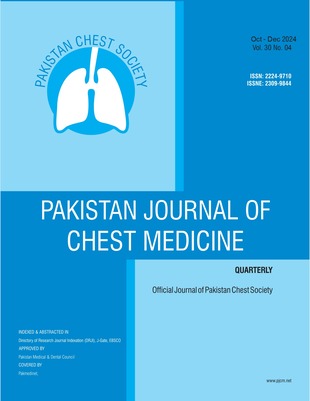Clinical, Epidemiological, and Microbiological Profile of Community-Acquired Pneumonia: A Cross-Sectional Study
Keywords:
Community-Acquired Pneumonia, CLSI, AntibioticsAbstract
Background: Community-acquired pneumonia (CAP) is a significant cause of illness and death around the world, especially in low- and middle-income countries. Its clinical features and the pathogens that cause it can differ by region. These differences are affected by existing health conditions and local resistance patterns. Knowing these factors is crucial for developing effective diagnosis and treatment methods. Objective: To assess the clinical presentation, epidemiological characteristics, and microbiological etiology of patients diagnosed with community-acquired pneumonia. Methodology: This study took place at a tertiary care hospital and involved 160 adult patients diagnosed with community-acquired pneumonia. We recorded detailed clinical histories, comorbidities, and radiological findings. Sputum samples were collected for bacterial culture and sensitivity testing using standard microbiological methods. We interpreted antimicrobial susceptibility following Clinical and Laboratory Standards Institute (CLSI) guidelines to identify resistance patterns. Results: Out of 160 patients, 76% were male. The most affected age groups were 31 to 40 years and 61 to 70 years. Common other health issues included hypertension at 24.3%, smoking at 21.8%, COPD at 20%, and diabetes at 18.7%. Sputum cultures tested positive in 65% of cases. The leading pathogens were Klebsiella pneumoniae at 44% and Pseudomonas spp. at 22%. There was high resistance to ceftriaxone at 83%. Conclusion: The study showed a heavy impact of CAP in middle-aged and older men with common health issues like hypertension and COPD. Gram-negative bacteria, especially Klebsiella pneumoniae and Pseudomonas spp., were the main pathogens. High resistance to cephalosporins restricts their use.References
Khan S, Rehman A, Zubair M, ul Haq M, Khan N. Frequency of Hyponatraemia in Patients Admitted with Community Acquired Pneumonia in Medical Unit of Teaching Hospital. Pak J Chest Med. 2022;28(3):297-301.
Musher DM, Thorner AR. Etiology of community-acquired pneumonia in adults: a systematic review. Pneumonia (Nathan). 2020;12:10. DOI: 10.1186/s41479-020-00074-3.
Cillóniz C, Dominedò C, Torres A. An overview of guidelines for the management of community-acquired pneumonia. Rev Recent Clin Trials. 2021;16(2):89–99. DOI: 10.2174/1574887115666210118121250.
Ziko LM, Hoffman TW, Fwoloshi S, Chanda D, Nampungwe YM, Patel D, et al. Aetiology and prognosis of community-acquired pneumonia at the Adult University Teaching Hospital in Zambia. PLoS One. 2022;17(7):e0271449. DOI: 10.1371/journal.pone.0271449.
Metlay JP, Waterer GW, Long AC, Anzueto A, Brozek J, Crothers K, et al. Diagnosis and treatment of adults with community-acquired pneumonia: an official clinical practice guideline of the American Thoracic Society and Infectious Diseases Society of America. Am J Respir Crit Care Med. 2019;200(7):e45–e67. DOI: 10.1164/rccm.201908-1581ST.
Faruqi A, Akhtar J, Ahmad I. Bacteriological profile and antimicrobial susceptibility patterns in community-acquired pneumonia in North India. J Family Med Prim Care. 2019;8(11):3631–3636. DOI: 10.4103/jfmpc.jfmpc_799_19.
Sariah QE, Manyahi J, Jullu BS, Kibiki GS, Mshana SE, Mmbaga BT. Microbial etiology and patterns of antimicrobial resistance in patients with community-acquired pneumonia in Tanzania. BMC Pulm Med. 2020;20:299. DOI:10.1186/s12890-020-01232-5.
Shah SM, Qamar FN, Ahmed A, Yousafzai MT, Khan E, Aziz M, et al. Global resistance rates in Acinetobacter baumannii: a systematic review and meta-analysis. J Antimicrob Chemother. 2023;78(4):1234–1241. DOI: 10.1093/jac/dkac123.
Jain S, Self WH, Wunderink RG, Fakhran S, Balk R, Bramley AM, et al. Community-acquired pneumonia requiring hospitalization among U.S. adults. N Engl J Med. 2015;373:415–427. doi:10.1056/NEJMoa1500245.
Woodford N, Patel JB, Livermore DM, Karaiskos I, Tzouvelekis LS, Abbott IJ, et al. Global trends in antimicrobial resistance among gram-negative bacteria: a network meta-analysis. Clin Infect Dis. 2022;75(5):987–995. doi:10.1093/cid/ciac789.
Balachandran A, Dhariwal AC. Systematic review and meta analysis of comorbidities and associated risk factors in Indian patients of community acquired pneumonia. Indian J Community Med. 2022;47(3):420–428. doi:10.4103/ijcm.IJCM_901_21.
Ishikawa N, Igarashi A, Takahashi M, Sugiyama H, Nagata H, Tanaka M, et al. The effect of comorbidities for the prognosis of community acquired pneumonia: epidemiologic study using hospital surveillance in Japan. BMC Infect Dis. 2020;20:568. doi:10.1186/s12879-020-05270-2.
Ojuawo OB, Oguntola AS, Lawan A, Salami O, Wahab K, Adeoti T, et al. Clinical and microbiological profile of adult inpatients with community-acquired pneumonia in Ilorin, North Central, Nigeria. Niger Med J. 2021;62(2):85–92. DOI: 10.4103/nmj.NMJ_158_20.
Feldman C, Anderson R. Epidemiology, virulence factors and management of the pneumococcus. F1000Res. 2021;10:F1000 Faculty Rev-500. DOI: 10.12688/f1000research.52144.1.
Mandell LA, Wunderink RG, Anzueto A, Bartlett JG, Campbell GD, Dean NC, et al. Infectious Diseases Society of America/American Thoracic Society consensus guidelines on the management of community-acquired pneumonia in adults. Clin Infect Dis. 2007;44(Suppl 2):S27–72. DOI: 10.1086/511159.
Iqbal R, Bashir U, Khan T, Shah NA, Bhat MA, Wani NA. Bacteriological and clinical profile of community-acquired pneumonia in hospitalized patients in Srinagar (Kashmir), India. Indian J Med Microbiol. 2005;23(3):149–152. DOI:10.4103/0255-0857.16035.
Abebe T, Bekele A, Tulu H, Gebremichael M, Fekadu S. Antimicrobial resistance trends among clinical isolates of Pseudomonas aeruginosa and Acinetobacter spp. at the Ethiopian Public Health Institute. Antimicrob Resist Infect Control. 2023;12:55. DOI: 10.1186/s13756-023-01355-4.
Downloads
Published
How to Cite
Issue
Section
License
Copyright (c) 2024 Pakistan Journal of Chest Medicine

This work is licensed under a Creative Commons Attribution-NonCommercial 4.0 International License.








